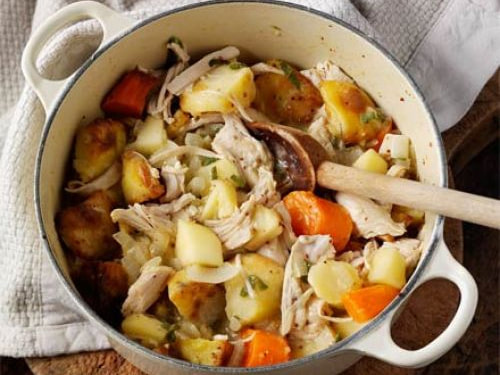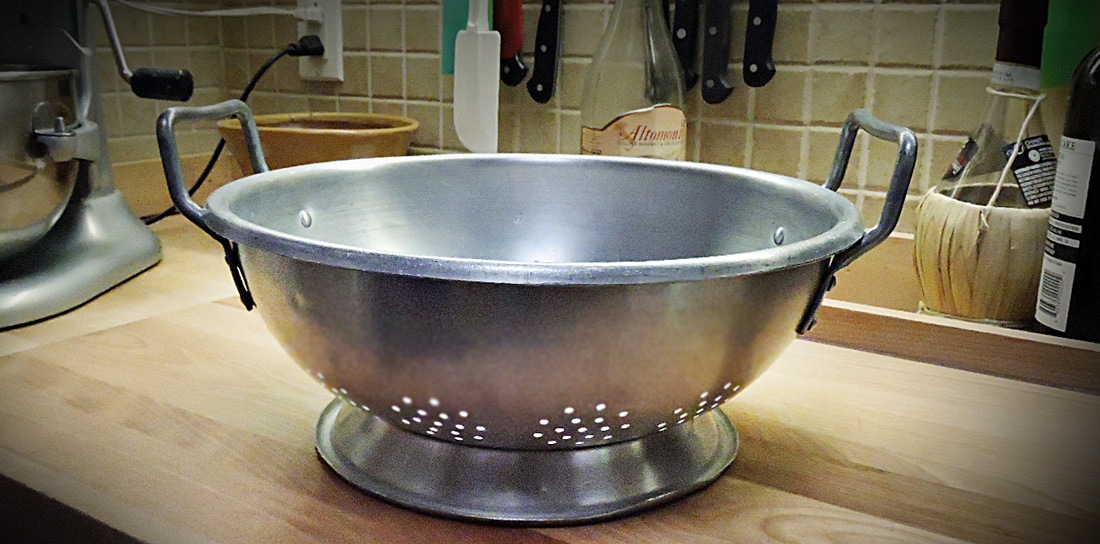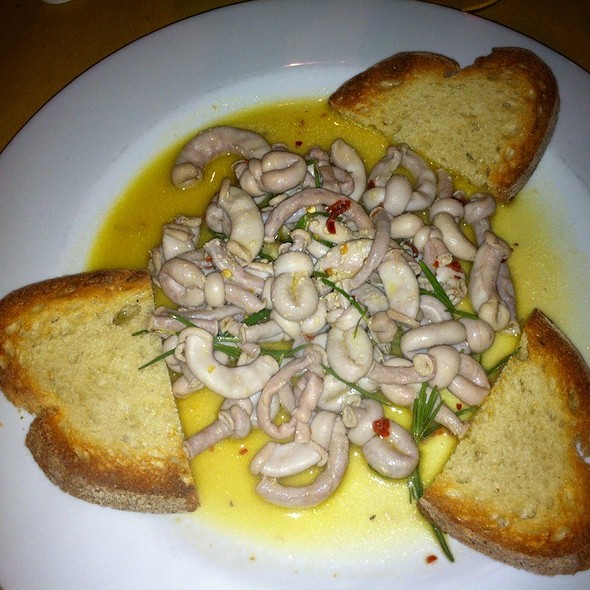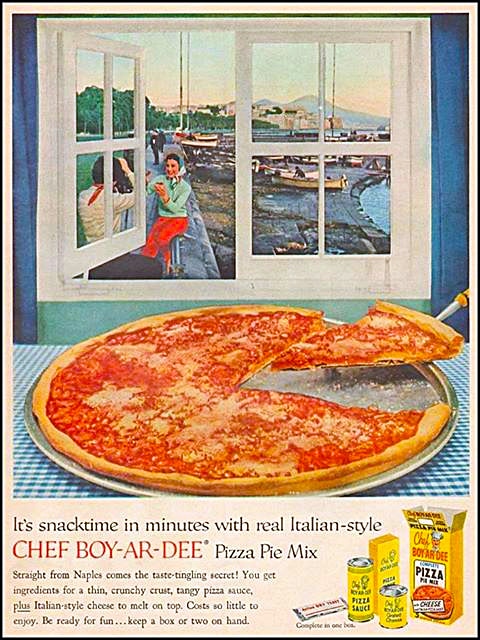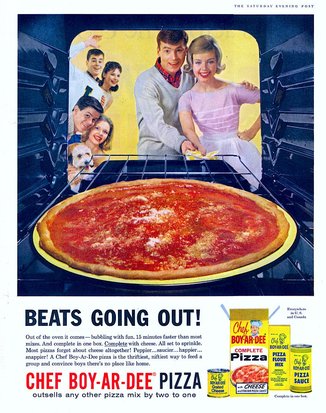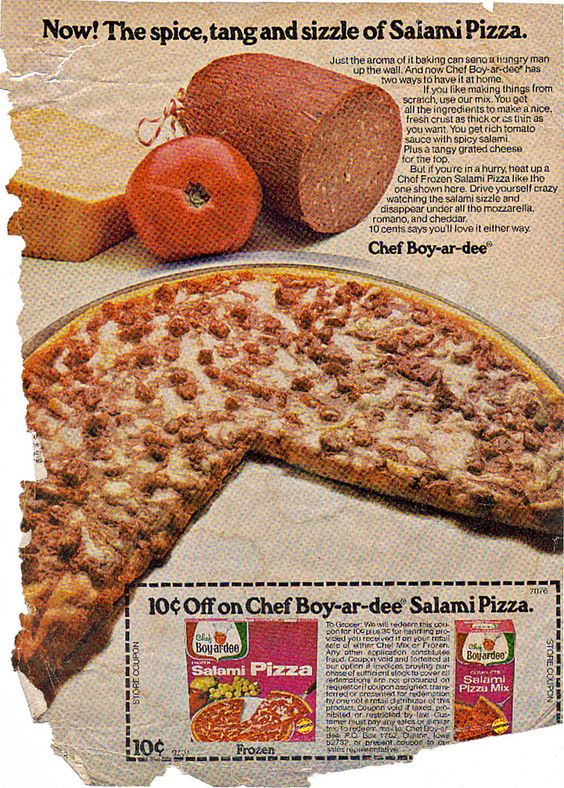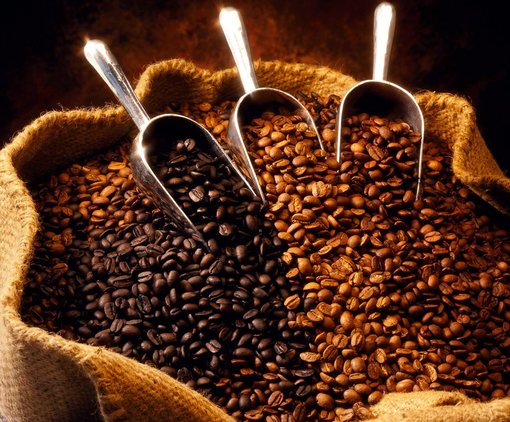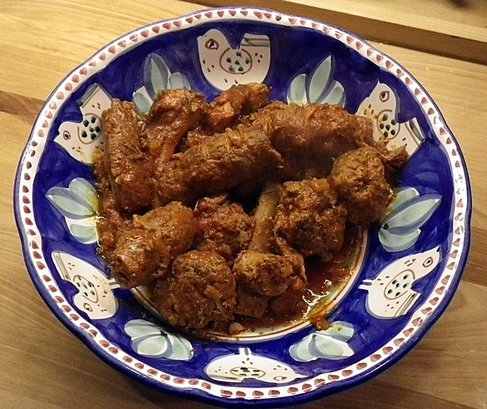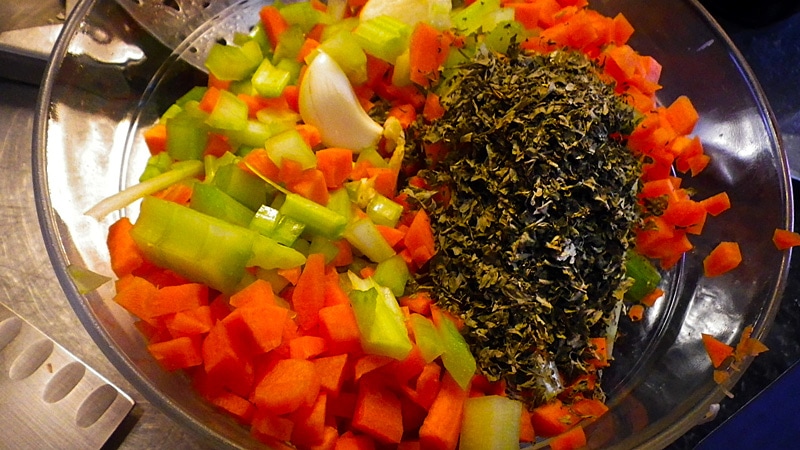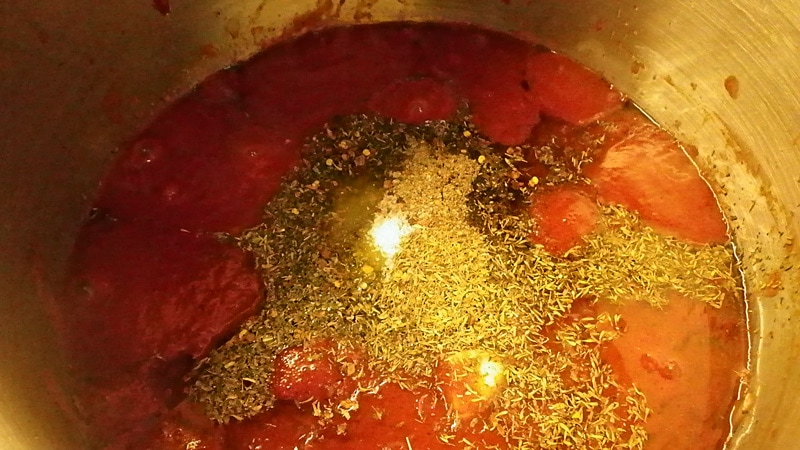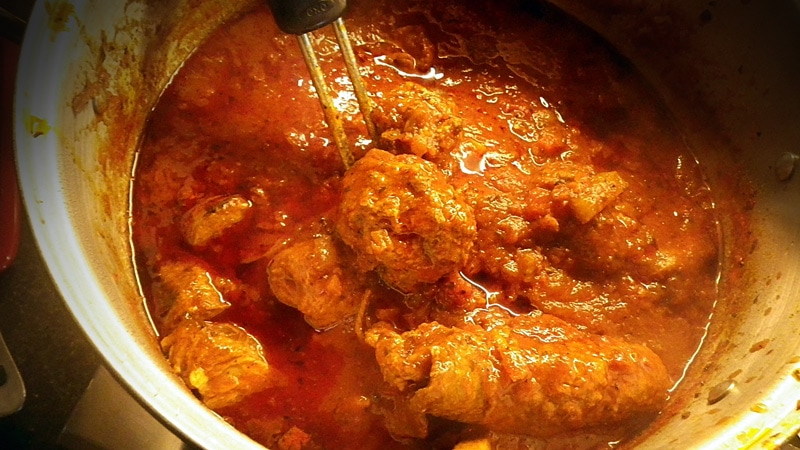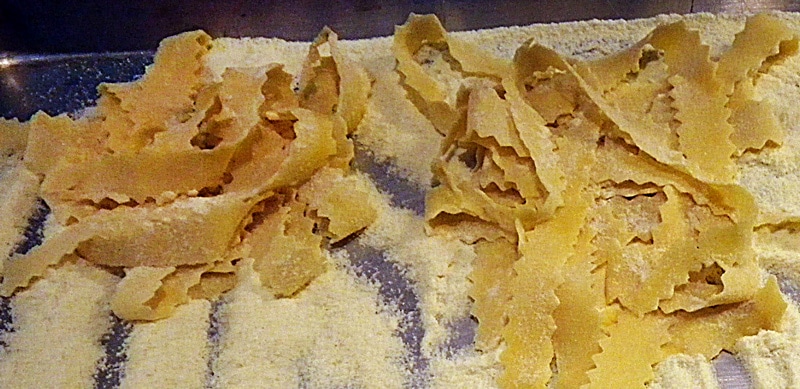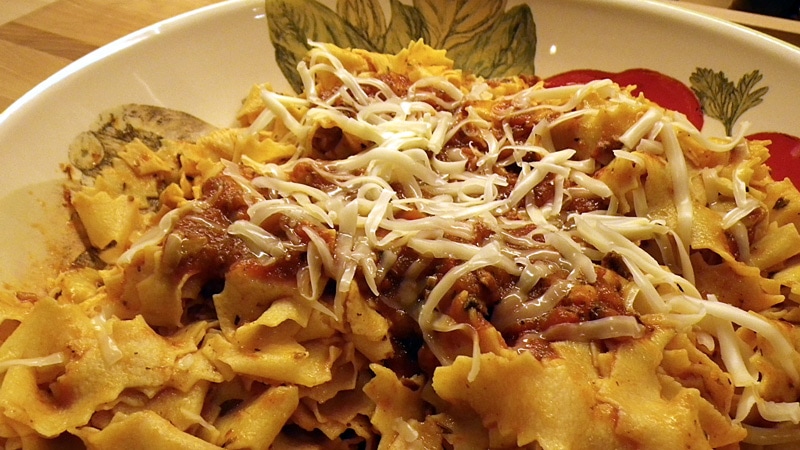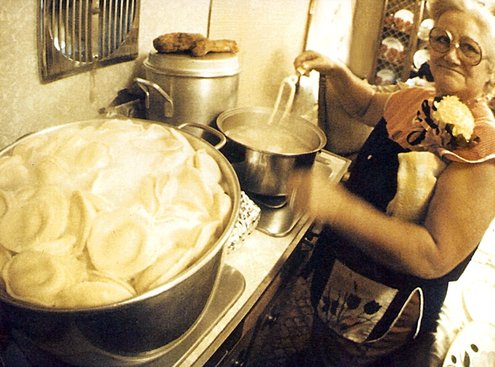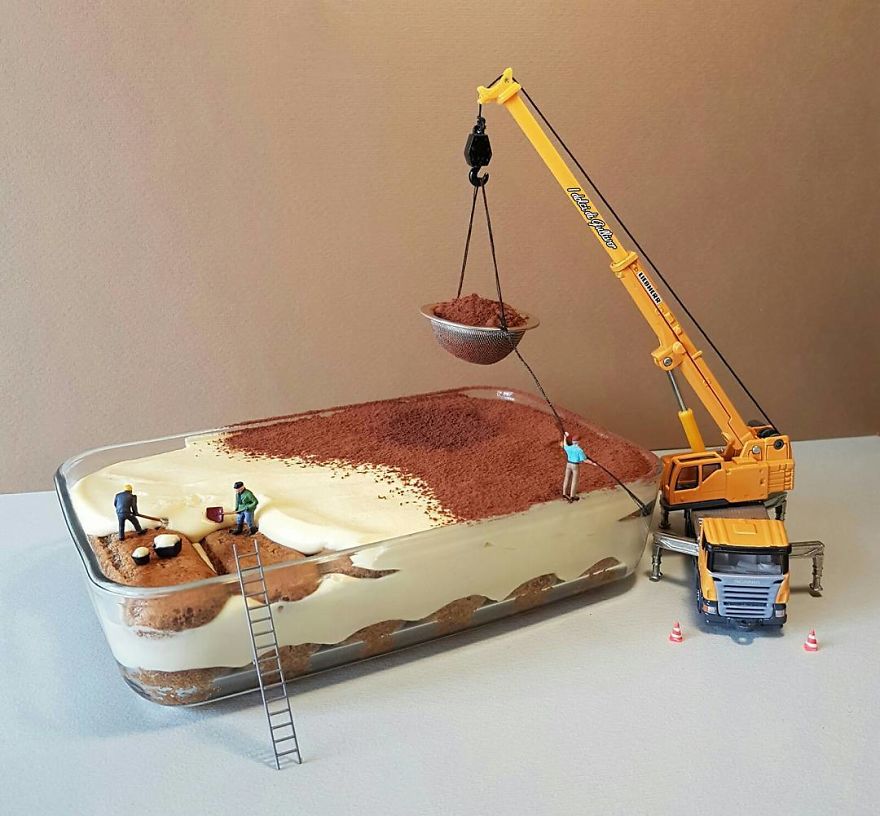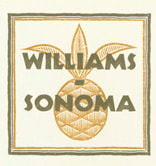|
When I was a boy, my father would often cook when my Mom was out with her "lady friends" to take in a Broadway show or an evening in a Manhattan night club. His style of cooking was something very different from my mother's... He would look into our old Philco refrigerator, see what was leftover or what vegetables we had, and somehow--without a recipe--whip something up to satisfy us for dinner. When I'd ask what we were going to have for dinner, he just say a dialect word which to my ears sounded like "ba-BOOK-ya", with the "ya" part trailing off becoming nearly imperceptible. I knew the adventure was about to begin... Recently, I was determined to research this word, even though I was unsuccessful in finding out its meaning in past attempts. But this time, I asked the friendly people in the I Love Molfetta Facebook page... and hit pay dirt! As it turns out, the word is papocchio... (or papocchia), pronounced "pah-POH-kee-yo". Now that I see it spelled out, I can picture my father pronouncing the "P"s almost like "B"s, with his soft-mouthed, mumbling Molfettese manner of speaking. Words are blended in his dialect. The end of words sort of trail off. So, "ba-BOOK-ya" fits perfectly with my memory! Papocchio can have multiple meanings: Intrigue, cheating, trickery, a mess. Shockingly, I have even discovered that the word was used by northern Italians to refer to someone messing up a situation, in the "typical Southern Italian style", or "papocchio". Wow! Northern Italians had many such words and idioms that denigrated the Southern Italian. So, in this context, a "papocchio" is described as a screw-up not worthy of being considered a Northern Italian. The sarcastic use of the word was used as the title of the 1980 comedy film Il Pap'occhio--the Pope's Eye. They took the meaning of the word "papocchio" and added the ' between the "pap" and "occhio" forming the compound word for Pope's Eye. It was such an irreverent look at the corruption of the Pope and the church that the film was shut down with two weeks of its release.  My dad, Sal My dad, Sal What does all this have to do with Dad's "ba-BOOK-ya" recipe? Not much, but it does give a lot of historical perspective to the word papocchio. When I asked my Dad for its meaning, he motioned with his hands with his fingers stretched out with a twisting movement, "When I was a kid we'd put everything in one bowl or pot... (hands twisting) all mixed up". He told how his poor immigrant family would gather around the table for the family meal, each having their own fork but only one big bowl in the middle of the table. He said that they would use whatever they had that day to make the meal... a tomato or two (if in season, grown in their tiny Hoboken backyard), some ramps (wild onions picked near the railroad tracks), broken up pieces of stale bread, potatoes, smelt or eel or crab (if he or his brothers caught any that day on the river), a bit of cheese, some salt and olive oil. Sometimes he would fry the leftover ingredients to heat everything together in a large pan. Other times he would make a sort of cold rice or pasta salad. He also liked to make a frittata using eggs as the base for all the found leftover ingredients. Mom had her mainstay recipes, but with Dad, it was as if he was a stand-up comic doing an improvisational skit--being able to handle whatever the audience threw at him. Ecco... Ba-BOOK-ya... Papocchio! Recipe? Not really... Here is the simple method of how my father, Sal might have thrown a papocchio together for a weekday meal.
If you have small bowls, portion out the dish. Otherwise, everyone grab a fork and dig in, but no fighting! Serve with crusty bread and a glass of red wine on ice mixed with 7-Up. That's the way Dad would have done it... --Jerry Finzi 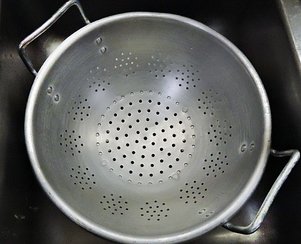 I never was interested in an inheritance from my parents. Not that I couldn't use some extra financial help when we had our son late in my life (I was 53 when he was born). After my Dad passed, my Mom didn't have all that much anyway... besides, I always felt strange about even discussing such things. When my Mom finally passed on some years ago, I actually refused to deposit the meager check my sister sent along after her affairs were supposedly "finalized". But when my Mom was alive she did "will" me some things in person when she was moving from her tidy suburban home to a senior citizen's apartment complex. I treasure these simple things. One treasure was her scolapasta. The literal translation of this essential kitchen tool is "dripping pasta", a very descriptive name for her colander. It might even me called scola maccharon' (macaroni drain) in southern dialect. My Mom would grab a mappine (pronounce mop-EEN, meaning dishtowel), pick up the boiling spaghetti pot and then dump the steaming pasta into the scolapasta to drain the water. I remember when she offered it to me... "Here, you take this home". It was like she was passing the culinary baton to me and my cooking. No fanfare. But with that simple statement, I was honored all the same. She must have poured several tons of pasta through that beautiful piece of aluminum for decades before I got it. It's a large one, too... holding two pounds of pasta. I've been using it every time we make pasta in the new Casa Finzi for over a decade now. It's amazing to think that this tool must be over 60 years old--at least--and still going strong. Try that with one made of plastic or from cheap Chinese steel. We actually have another colander that we bought in the famous Dehillerin kitchen shop in Paris, but somehow we always reach for Mom's scolapasta first... Thanks Mom. --Jerry Finzi  Perhaps this headline should read: The Most Controversial Man of the Last Century Passed Away... After all, whenever the subject of Hawaiian Pizza comes up, people either go into a rage or rave about the stuff---they are rarely ambivalent on the subject. Mention this recipe to an Italian and they will more than likely offer some choice hand-gestures, facial expressions and perhaps some choice words to show their contempt for this disgustoso breech of pizza etiquette. The Hawaiian Pizza idea was invented by Sam Panopoulos---yes, he was a Greek-Canadian, not Italian. But then again, neither is Hawaiian Pizza. Panopoulos came up with the idea in his restaurant back in 1962. "Along the way, we threw some pineapples on it and nobody liked it at first, but after that, they went crazy about it. Because in those days nobody was mixing sweets and sours and all that. It was plain, plain food." Personally, I love Hawaiian Pizza. I think the first time I ever had some was in the just-opened Pier 17 food court down at South Street Seaport in Manhattan back in 1983. I loved the way the salty ham, sweet pineapple and tomato sauce married well with each other. The acidity in both the pineapple and tomato sauce make them compatible cousins. And mozzarella on top of pineapple? Well, not exactly... it goes under them, allowing the pineapples to caramelize, bringing out their sweetness a bit further. The bits of ham (sliced or chunks, I've had it both ways) also go above the cheese to bring out a smokey flavor.
The Recipe is Still Pizza After All...
Prepare the dough, form your pizza round, top with sauce, then mozzarella, and finally with the pineapple and ham. Drizzle with a little Extra Virgin olive oil and a dusting of dried basil. Bake in a 515 F oven for 5-7 minutes, preferably on a pizza stone or baking steel. Your oven may vary... keep an eye on this, ensuring that the crust bottom is done along with the toppings. If your crust is done before the toppings, put the oven on broil for an extra 1/2 minutes. Panopoulos arrived in Canada with his brothers in 1954, opening several restaurants. He passed away in an Ontario hospital on June 8, not long after he had celebrated his diamond wedding anniversary with his wife Christina. He was said to have an "unforgettable" personality and was known to be up-front and full of humor. He leaves behind his family, friends, former employees and loyal customers. He was 83.
--Jerry Finzi Covfefe Recipe only a Pugliese Nonna Would Love Ingredients 1 kilo fresh killed covfefe 1 cup orangecello 1 tablespoon red pepper flakes 2 tablespoons Golden Extra Virgin Olive Oil a healthy sprinkling of Rose and Mary and Poppy salt to taste slices of stale bread, toasted golden around the edges Directions Prepare covfefe... don't bother to clean. Cut up into random sized pieces. Boil covfefe in a rolling boil for 5 hours, preferably after midnight while you sleep. Throw all the other ingredients hodgepodge into a large frying pan and then briefly into the fire. Drain the covfefe and toss with the sauce. Serve in a large heap with slices of golden toast around all sides to protect it from diners. Recommended wine to accompany your covfefe: Your choice and as much as possible. --Jerry Finzi A Humor Piece, Copyright 2017, Jerry Finzi/GrandVoyageItaly.com
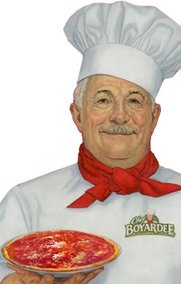
Hector Boiardi was born in the Emilia-Romagna town of Piacenza in 1897, and working as an apprentice chef at a local hotel before he even reached his teen years. Hector came to America in 1914, and eventually became the head chef of New York’s famed Plaza Hotel. His clientele kept asking for the recipe for his tomato sauce, which caused him to create Chef Boyardee brand, a phonetic spelling of his surname.
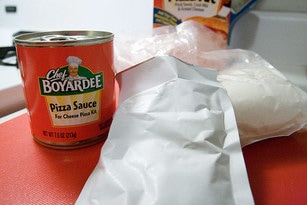
In 1955 he started to offer boxed pizza kits which included everything you needed to make a pizza from scratch in your own home kitchen--a revolutionary idea at the time. Nowadays, companies like Blue Apron and others delivering similar complete menu kits to your door owe a nod to the pioneer of this meal marketing concept--Chef Boyardee.
The pizza kit contained a small packet of parsley, a can of sauce, some yeast and flour and a packet of parmesan cheese (no mozzarella). Sausage and pepperoni kits included the meat right in the can of sauce.
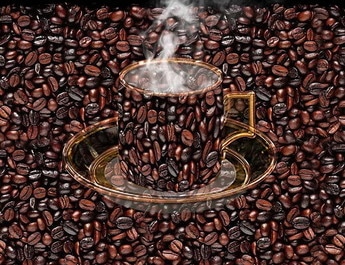 In the centuries before the iconic Bialetti Moka pot, people drank the new beverage in coffeehouses, an idea that started in Constantinople around 1550, but also spread to Mecca, Damascus and Cairo. Although David ibn Abi Zimra (a Cairo rabbi) ruled in 1553 that Jews could drink coffee prepared by a non-Jew, he also warned against patronizing public coffeehouses and suggested that instead, they have their coffee deliver to their homes--especially due to its medicinal use. Initially, in the 15th century, the drink quickly spread throughout the Ottoman Empire, enjoyed with large amounts of sugar. Jews and Muslims alike found that it helped them stay awake and alert for nightly prayer services. For Muslims, it took the place of forbidden alcoholic beverages. For the Jews, its adoption was tentative with rabbis debating whether it was Kosher, what blessing it required or whether it was actually a medicinal drug. Coffee in Italy had a slow start, partly due to it being declared a Drink of the Devil and outlawed by the Catholic church, and later, because it was a very expensive drink for the elite. The Church considered it as being "the bitter invention of Satan", and also bemoaned of its links to Islam. It wouldn't be until 1603 when Pope Clement VIII tasted--and liked--coffee and gave the drink full absolution from its sins. This helped open the floodgates for coffee in Italy and the rest of Europe. In 1632, the Jews of Livorno--a port city that was given over to the Italian Jewish population which became a center of Mediterranean trade--imported the first coffee into Italy and then opened the first coffeehouses (Bottega del Caffè). By 1624 and 1650, large shipments were shipped to Venice and by 1683, the first coffeehouse in Venice opened. In researching this article, I actually discovered that in 1766, an ancestor with my family name, Beniamino Finzi (an Italian Jew) was given management of a coffeehouse in Livorno. He managed to get the Jewish leaders to rescind a law forbidding games of chance in coffeehouses frequented by Jews. He was the first Jew to be granted a permit to allow gambling with card and board games in a coffeehouse. From this time on, a Jew could only run an "entertainment room" for gambling only if they also served coffee! Coffee was becoming mainstream.... within 200 years of the first sip being tasted in Italy, the craving for coffee had spread throughout Europe and even into the New World. --Jerry Finzi 4/7/2015 Nearly every Sunday of my early childhood my Mom made something most Italian-Americans (especially those from Naples) called Sunday Gravy. Simply put, Sunday Gravy is essentially a large batch of tomato sauce with various types of meat slow cooked into it. In Italian, the word salsa means sauce... a sauce is made from something other than meat. Like putting a fruit or cheese sauce over meat, chicken or fish. The Italian word sugo means gravy. A gravy is made from the liquids and fat that are rendered from various meats--like using turkey drippings to make a gravy. The all-day cooking of meat in tomato sauce gives off a heady scent, that would fill our apartment, and waft out into the hallway for the entire building to smell--"Ahh... the Finzis are making Gravy today!" The secret of Sugo is in its slow cooking, or pippiare (literally, to bubble) technique. Sunday Gravy has it's origins from a beef stew popular in medieval XII-XIV century, way before tomatoes were introduced from the New World--a clay cooker slow cooked the stew of beef and vegetables for hours and hours. This beef stew turned into a ragù, at first created in northern Italy, with the southern Neapolitans evolving the dish further by the eighteenth century. It began as a a dish for nobility, using more expensive cuts of meat, such as beef and veal, but no tomato. (Tomatoes didn't gain popularity right away in Europe... they were thought to be poisonous). This dish was mainly prepared on Sundays, the sauce placed on top of the pasta, with larger cuts of meat served as a second course. One historian described a Sugo using tomatoes in 1857 that was being served in taverns in Naples. You can think of Sunday Gravy is a hybrid of sorts... it starts out as a tomato sauce and becomes a gravy after meats have been added and have rendered their flavors during a long cooking period--the Sunday Gravy of my childhood. 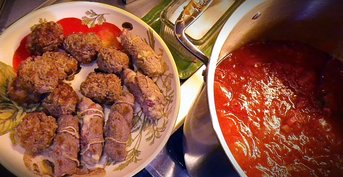 Some of the meat ready to be added to the Gravy Some of the meat ready to be added to the Gravy But Sunday Gravy wasn't just about a making a single meal in la nostra casa. It was an event--a gathering. Making Sunday Gravy is reminiscent of an entire village doing their weekly communal cooking... coming together to make pasta, make bread, make the olive oil, tend the olive trees, fix a roof, gossip, laugh and be together. In Italian communities, ovens were often communal, but ingredients were also communal in many respects--Giuseppe just slaughtered a large pig and barters off some of the meat with Mario, the baker for bread, or perhaps his cousin Maria still has some tomatoes hanging that she would swap, and Marcello's owes him some olive oil to offset the wine that was traded last spring for some pasta. Food was communal. Food was family. And good food takes time and preparation and lasts for more than a single meal... My Mom started making Sunday Gravy sometimes on Saturday... or even in the middle of the week before. Being a working Mom and was frugal with her time. She would make a meat dish one night--maybe the meatballs. Then she'd give us a simple dinner with some of them, but hold most of them for adding to the Sunday Gravy pot. Maybe on Saturday after shopping, she'd make the brasciole and brown the pork ribs under the broiler. These would also go into the fridge, ready for the Sunday Gravy pot. Sunday morning would arrive and I'd go to Mass with one of my sisters and then stop at a bakery to pick up "buns" for our whole family--even my Aunt Rose's family who lived upstairs. In our family's jargon, "Buns" were anything sweet from the bakery... cream donuts dusted with cinnamon, raisin "buns" (my favorite), a crumb cake with crumbs as big as my 5 year old fist, a cheese danish that would fill a plate, and maybe a dozen "mixed buns"... assorted goodies that the person behind the counter would surprise us with
Sunday Gravy wasn't just about the one meal. It was also about what we'd be eating in the coming week--there would be lots of leftovers in that big pot. The gravy might even allow us to cheat a little on "meatless Friday" by using just the tomato sauce without any meat on pasta, ravioli or with fish. And everyone knows that Gravy tastes even better over the next few days. The flavors of all those meats meld into the sauce turning it magically into a true gravy--rendered from meat. It's a carnivore's manna--nectar straight from our Roman and Greek bloodlines. My Dad's very large family ate from a single pot.... and a single bowl in the middle of the table. You can imagine the Sunday Gravy there with brothers and sisters taking a meatball here, a rib there... a couple of these meats, a piece of bread or pasta and some of this gravy and you had an incredible meal. Filling, nutritious and delicious. A necessary thing when our Nonna's had so many mouths to feed with so little. 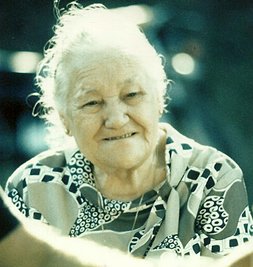 Mariantonia Delulia, my Grandma Mariantonia Delulia, my Grandma In our famiglia, there were lots of mouths to feed--seven of us in our family, and the dog. My cousins and Aunt would stop by, too. Then there were my sisters' girl friends and my brother's crew. There were always extra plates for whoever stopped by. It was about the famiglia... the heritage... the food... the tastes that even our memories had forgotten and unknowingly were our a link to our past.... Naples, Molfetta... and my maternal Grandmother, Mariantonia Delulia. (Once I learned her real name I was compelled to say her full name over and over... like poetry off an Italian tongue... "Maree - ahn-TONE-eaa-ahh Day-LULE-eeah". ) This wonderful lady towered over me (as a small child) at 4' 10", with her greyed hair tucked into a bun in the daytime, but releasing nearly three feet of it down her back at night before bed. Grandma made her own version of Gravy... everyone does it slightly differently. She'd add large strips of peppers and larger chunks of onions, and put pignoli in her meatballs. A cut up pork shoulder (the affordable cut for poor immigrants, when they could afford it) was key to her recipe, along with hot sausage (way too spicy for my young tongue back then). Before we would get through the comics, our little railroad apartment would start to smell differently.... sweet, pungent... Italian. Mom would start by taking a huge onion and cutting it up into small pieces... and sautéing them in the bottom of her huge stock pot on the kitchen stove until they were soft and glistening and letting off their pungent scent. Then she would add the diced carrots, celery and garlic. After that, my Dad would get the wine from the cellar (he'd sometimes have jugs of some home made wine he got from my Uncle down there) and pour some into the pot. Not sure how much.... maybe a couple of cups. Next, Mom would let one of us open the cans--big cans of imported tomato puree. It was fun opening cans using the wall-hung can opener over by the dumb waiter door (nailed shut by Dad so us kids wouldn't try to go for a ride.) About four or five cans would go into the pot. Next came the spices. A handful of sugar to cut the acidity, half-handful each of dried basil, oregano, thyme, garlic powder (or a 5-6 cloves of fresh when Mom had it), a good sprinkle of red pepper flakes, a tablespoon each of salt and pepper, then a quarter cup of olive oil. If Mom had any leftover rinds of cheese from a grating wedge, they'd go in too. Then she'd take out the meat... lots of it. A rack of ribs cut up would be layered in like logs at the bottom of a red lake. Then would come the sausage browned and cut up into 2 inch pieces, then add the brasciole--all tied up like meaty little packages, and then the meatballs. Then the Sunday Gravy pot is put on the back burner--the smallest one--and starts to simmer and simmer, bubbling like a crater of lava from the old world. The aromas get more and more intense as the day goes on--you can taste the flavors turning the tomato sauce into something... luscious. My siblings' friends come and go with an open door policy, my mother always inviting them to have a "bun" or sit down for a meatball sandwich. There was more than enough... a few would never be missed. As for us, we would taste the Gravy all day long by getting a piece of bread and spooning some on top. What a treat. I still do this when I make gravy--or sauce. Taste it on top of a piece of bread... fine tune the spices, then simmer some more. Lucas is growing to love this little snack way before dinnertime. In the Fifties we would sometimes eat Sunday "dinner" at 2 in the afternoon if my Mom was lucky enough to get the Sunday Gravy in the pot early enough. Otherwise, we'd eat by 5 or so. There was no set dinner time on Sundays in our house. Besides, we had "buns" in our bellies--the starch, fat and sugars keeping our fluttering young hearts going. No one went hungry on Sundays. 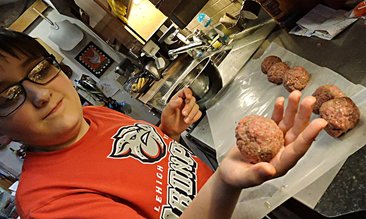 Shaping meatballs Shaping meatballs The New Famiglia Finzi "Gravy" This past Easter I made Sunday Gravy, as I described above. I didn't follow a recipe... I followed my memories. Perhaps this is why I didn't write this article as I would a normal recipe. I don't want people to simple follow the recipe in any strict way. This a recipe that needs to be felt. Vary it with love--the things you love, and share it with people you love. Make meals out of its components both before, during--and after--making it. We've already had two meals from it. It all came together for Easter Sunday's late afternoon meal, as my family had done time and time again so many years ago. We'll probably freeze half of it for future meals. We made home made tagliatelle to have with it the first night and a risotto for another meal on another day. But we also had each other. We shared garlic bread and wine with it--Lucas had a little glass too. I'm teaching Lucas how to drink with a meal rather than drink to get drunk. He places a small forkful of meat in his mouth, chews a bit, sips some wine and discovers the flavors as they mingle and merge into something Godlike. 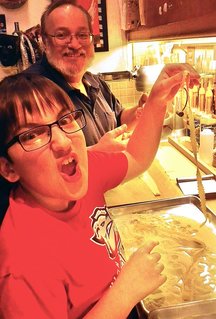 Making the tagliatelle Making the tagliatelle Making Sunday Gravy was like having a family Mass with a prayer beforehand, and more afterwards. It's a joy to watch my boy Lucas' eyes light up as he discovers great flavors. Lisa helped me with some parts of the meat preparations as early as Thursday. Lucas helped make the meatballs and the pasta. Lucas is also a spice expert (great palette on that kid), so I told him to, "Make an Italian tasting spice rub for the ribs". He nailed it. Mom made the risotto we had for our second meal (her first time making risotto... usually I do all the stirring). The Gravy mixing with the rice turning it into something dreamy. Traditions--or perhaps I should say rituals-- are important in our family, and in our food. After all, the food holds ties to our heritage and the food eventually becomes us. Literally and spiritually.
Happy Easter. And thanks, Mom for all those tasteful Sundays. --Jerry Finzi |
Archives
July 2023
Categories
All
|

